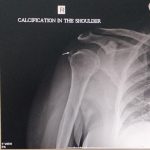27 Jun SLEEPLESS NIGHTS DUE TO SHOULDER PAIN
SUDDEN INCREASE IN SHOULDER PAIN AND SLEEPLESS NIGHTS
What could be the reason ?
Calcific tendinopathy/tendinitis and Adhesive capsulitis of the shoulder are the two main causes of sudden increase in shoulder pain during the night with disturbance to sleep.On the left side should always rule out heart problem.
What is Calcific Tendinopathy/Calcific tendinitis?
It is a form of aging changes in the shoulder cuff, which is accompanied by local deposition of calcium salts, predominantly HYDROXYAPATITE in the rotator cuff tendon.
What is the incidence ?
According to an US based study done using Ultrasonography it is present in about 3% of the adults.
More often in the females compared to males , from their fourth to sixth decade (40yrs- 70 years of age).
Among the rotator cuff tendon the Supraspinatous tendon (SST) has an incidence of around 80% , Infraspinatus (IFT ) -15% and Subscapularis tendon (SUB)-5% .
Very rarely it is also seen in the Teres Minor , Pectoralis Major and the Myotendinous region of the Biceps tendon.
What are the signs ?
Patients come to the OPD with recent onset of pain gradually increasing intensity mostly intolerable pain in the night with sleep disturbance . Very rarely patient can also have fever.
When the disease is in the resorptive stage there is limitation of movement in the affected shoulder.
What are the treatment modalities ?
DIAGNOSIS :
- X-Ray of the shoulder
- Ultrasonography to localize the tendon involved , site , size and stage of tendinitis and confirmation of the diagnosis.
TREATMENT :
(A)Sub-acute and mild pain – Painkillers(NSAIDS) , Physiotheraphy
(B)Acute and intolerable pain – Ultrasound guided aspiration and Lavage of the calcium deposit – BARBOTAGE . It is a procedure done under Local anaesthesia with minimal pain , followed by injection of local anaesthetic and injectable steroid .
Post procedure patient has excellent pain relief with reduced requirements of the pain killers .



No Comments